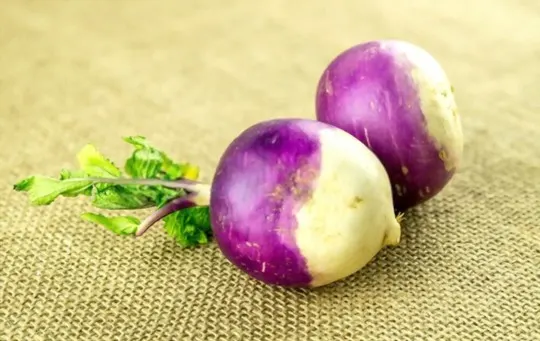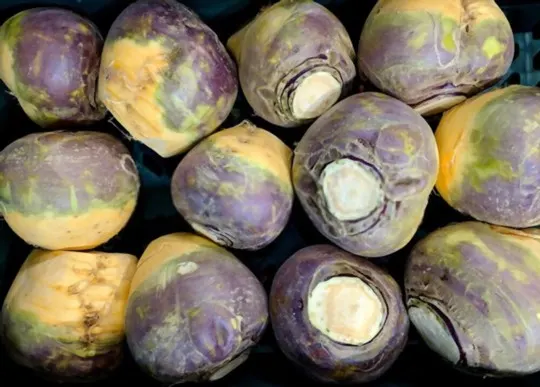Have you ever seen a rutabaga before?
It may look like an odd-shaped turnip, but it’s actually quite different! Rutabagas are packed with flavor and nutrition – if only you knew what to do with them.
Do you know what does a rutabaga taste like?
You’re about to find out: in this comprehensive guide, we not only explain the flavors of rutabaga but also offer tips on how to enjoy it as part of delicious meals or snacks.
From roasting and mashing to blending into velvety soups and salads, let us show you all the ways that they can make your recipes even more memorable!
What is Rutabaga?

Rutabaga, also known as swede, is a root vegetable that belongs to the brassica family.
It is a cross between a turnip and a cabbage, with a subtle, sweet, and earthy flavor that is often described as a cross between a carrot, a turnip, and a cabbage.
Rutabaga is high in fiber, vitamin C, and potassium, and is often used in soups, stews, roasts, and casseroles.
It can be mashed like potatoes or roasted with other root vegetables for a delicious side dish.
The leaves of the rutabaga plant are also edible and can be used in salads or sautéed as a side dish.
Overall, rutabaga has a unique and savory taste that adds depth to many recipes.
To enhance the flavor of your rutabaga dish, roast it with olive oil, salt, and pepper, or mix it with other root vegetables like carrots and parsnips for a colorful and flavorful side dish.
What Does a Rutabaga Taste Like?

Rutabaga has a unique flavor which can be described as a combination of turnip and cabbage, with a slightly sweet and nutty taste.
When cooked, rutabagas become tender and creamy, making them perfect for soups and stews.
They can also be roasted, mashed, or baked to create a variety of dishes.
Rutabagas have a yellow-orange flesh that becomes sweeter in colder temperatures, and a tough outer skin that needs to be peeled before cooking.
Low in calories and rich in Vitamin C and fiber, rutabaga is an excellent addition to a healthy diet.
To balance out the slight bitterness of rutabaga, try pairing it with sweeter vegetables such as carrots or sweet potatoes.
Factors that Affect the Taste of Rutabaga

Rutabaga is a root vegetable that has a slightly sweet, earthy, and nutty flavor.
The taste of rutabaga can be affected by various factors, such as its age, cooking method, and the soil it’s grown in.
Here are a few factors that influence the taste of rutabagas:
- Age – Younger rutabagas tend to be sweeter and less fibrous than older ones, which can be woody and tougher to eat.
- Cooking method – Boiling and steaming rutabagas can make them milder and sweeter, while roasting them can enhance their nutty flavor.
- Soil – The taste of rutabaga can be influenced by the type of soil it’s grown in. Rich, loamy soil tends to produce sweeter and more flavorful rutabagas than poor or sandy soil.
To make the most out of the rutabaga’s sweet flavor, try using it as a substitute for potatoes in dishes like mashed potatoes, fries, or stews.
1 – Age and Maturity
When it comes to rutabagas, age and maturity play a significant role in their flavor and texture.
Young rutabagas tend to be sweeter and softer, while older ones are more fibrous and have a stronger, earthy taste.
However, regardless of their age, rutabagas are often described as having a slightly bitter and peppery taste with a subtle sweetness that is similar to turnips.
They are also known for their dense and starchy texture, making them an excellent option for mashing and roasting.
To make the most of your rutabaga, it’s recommended to cook them with other vegetables or seasoning to help balance out their strong flavor.
You can try adding them to stews, soups, or roasting with sweet potatoes and carrots for a sweet and savory side dish.
To ensure a smoother and sweeter flavor, peel the rutabaga first and boil it until it’s fully cooked before roasting or mashing.
2 – Cooking Method
Rutabaga, also known as swede, is a root vegetable that has a slightly sweet and nutty flavor, similar to a combination of turnips and cabbage.
When cooked, rutabagas have a tender texture that is perfect for mashing, roasting, or grilling.
A few popular cooking methods for rutabagas include:
- Roasting: Coat the peeled and cubed rutabaga with oil, salt, and pepper, and roast in the oven for 30-40 minutes until golden brown.
- Mashing: Boil the peeled and cubed rutabaga until tender, then mash with butter, cream, and your desired seasonings.
- Grilling: Slice the peeled rutabaga into wedges, coat with oil and spices, and grill for 15-20 minutes until tender.
Rutabagas are versatile and can be used in many different dishes, including soups, stews, casseroles, and roasted vegetable medleys.
3 – Seasonings and Spices
Rutabaga has a rich, earthy flavor that is often described as a milder version of a turnip.
The taste can vary depending on how it is prepared and what other seasonings are used.
Rutabaga can be enjoyed cooked or raw, and is often used as a substitute for potatoes or turnips in recipes.
When cooked, rutabaga takes on a sweet, nutty flavor and a slightly firmer texture than a potato.
You can enhance the flavor of rutabaga with spices and seasonings such as salt, pepper, cinnamon, ginger, or nutmeg.
With its distinct flavor and versatility, rutabaga is a delicious and healthy addition to any meal.
Health Benefits of Eating Rutabaga

Rutabaga is a root vegetable that is often overlooked but packs a powerful nutritional punch.
With its slightly sweet and nutty flavor, it is a great addition to any meal.
Here are some of the health benefits of eating rutabaga:
- High in fiber: Rutabaga is packed with dietary fiber, which can help improve digestion, prevent constipation, and lower cholesterol levels.
- Rich in vitamins and minerals: Rutabaga is an excellent source of vitamin C, potassium, magnesium, and calcium, which are essential for a healthy immune system, strong bones, and optimal nerve and muscle function.
- Low in calories and carbohydrates: Rutabaga is a great option for those who are watching their calorie and carbohydrate intake, as it is low in both while still providing key nutrients.
So next time you visit the grocery store, don’t forget to pick up some rutabagas and add them to your meals for a healthy and delicious boost of nutrition.
How to Prepare and Cook Rutabaga?

What Does a Rutabaga Taste Like? Everything You Need to Know.
Rutabaga has a slightly sweet and nutty flavor that is reminiscent of turnips and cabbage.
Its texture is similar to a potato, but slightly denser and firmer.
To prepare and cook rutabaga, follow these steps:
- Peel off the thick, waxy skin with a vegetable peeler.
- Cut the rutabaga into small cubes or chunks.
- Boil the vegetable in salted water for 15-20 minutes until it becomes tender.
- Drain the water and mash the rutabaga cubes thoroughly, adding butter or cream to taste.
- To roast rutabaga, toss the cubes in olive oil, salt, and pepper, and bake at 375°F for 25-30 minutes until golden brown and crispy.
Rutabaga can be enjoyed as a standalone side dish or as an ingredient in stews, soups, and casseroles.
Recipes Featuring Rutabaga

Rutabaga is a root vegetable that has a sweet and slightly bitter taste, making it a unique addition to any dish.
It resembles a turnip and is commonly used in dishes such as stews, soups, and casseroles, both for its earthy flavor and its low carbohydrate count.
If you’re curious about trying rutabaga in your meals, here are some delicious recipe ideas:
- Rutabaga Fries: Slice rutabaga into strips and bake them with oil and spices.
- Rutabaga Mash: Boil and mash rutabaga with butter, salt, and pepper for a delightful side dish.
- Rutabaga and Carrot Soup: Simmer rutabaga and carrot with broth and coconut milk for a comforting and nutritious soup.
- Rutabaga and Beef Stew: Add rutabaga to your beef stew for extra flavor and texture.
Pro tip: To cut down on the bitter taste of rutabaga, soak the diced or sliced vegetable in cold water for 10-15 minutes before cooking.
Where to Buy Rutabaga and How to Store It?

Rutabaga, a root vegetable that originated in Scandinavia, has a sweet and slightly bitter taste with a texture similar to a potato.
Here’s everything you need to know about buying, storing, and cooking with rutabaga.
Where to buy rutabaga? Rutabagas can typically be found in the produce section of most grocery stores, especially during the fall and winter months.
They are often sold alongside other root vegetables like potatoes, turnips, and carrots.
How to store rutabaga? Rutabagas can be stored in a cool, dry, and dark place like a pantry or root cellar for up to three weeks.
If you’ve cut into the rutabaga, store it in the fridge in a sealed container or plastic bag for up to one week.
Rutabagas are a versatile vegetable that can be roasted, mashed, fried, or added to soups and stews.
Try swapping potatoes for rutabagas in your favorite recipes for a healthier and slightly sweeter alternative.
Conclusion
In conclusion, rutabaga has a mildly sweet and nutty flavor with a slightly bitter aftertaste.
Its texture is similar to that of turnips, but more fibrous and starchy.
Rutabaga is an excellent source of Vitamin C, fiber, and potassium, making it a great addition to any diet.
Apart from its nutritional benefits, rutabaga can be cooked in multiple ways, including roasting, boiling, or mashing.
Its versatility makes it a popular ingredient in soups, stews, and casseroles.
So, don’t hesitate to add this nutritious and delicious root vegetable to your diet and culinary repertoire.

What Does a Rutabaga Taste Like? A Comprehensive Guide
Ingredients
- Rutabaga
- Ingredients from your selected recipes
Instructions
- Select your favorite ingredient from the range available in this article.
- Collect all the necessary items to make the recipe.
- Use the instructions provided to prepare a delicious dish in 30 minutes or less.

Carrie is a food writer and editor with more than 15 years of experience. She has worked for some of the biggest names in the food industry, including Bon Appétit, Food & Wine, and Martha Stewart Living.
As the Editor in Chief of IntroChicago.com, Carrie oversees all of the content on the site. She also manages the team of contributing writers and editors, who help to create delicious recipes, helpful tips, and informative articles that you’ll find on the site.
A native of the Chicago area, Carrie is passionate about all things food. She loves trying new restaurants and experimenting with new recipes in her kitchen. She’s also a graduate of the Culinary Institute of America, so she knows a thing or two about food!
